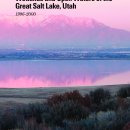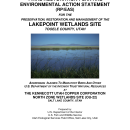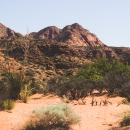Just as environmental pollutants (contaminants) can harm people, they can also harm wildlife. Wildlife can be exposed to contaminants directly, for example when birds forage in contaminated sediments and pick up pollutants through “incidental ingestion” (ingestion of sediments attached to food); or they can be exposed indirectly by consuming prey that have accumulated contaminants. Where contamination is severe, entire populations of wildlife may be negatively affected. Consequently, humans may experience reduced angling, hunting or recreation opportunities. Over 100 million people spend more than more than $140 billion per year on these activities, so the economic impact of environmental contamination of wildlife and their habitats can be significant.
The our Utah contaminants program is dedicated to protecting wildlife and their habitats from pollution's harmful effects, helping to create a healthy world for all living things. Environmental Contaminants (EC) specialists within our office work with other fish and wildlife biologists, scientists and partners to assess, clean up and restore habitats that are important to wildlife and people.
Assess
- Assess contaminant impacts - understand the mechanisms of how contaminants accumulate and/or degrade in the environment, how wildlife may be exposed, and whether levels of exposure are harmful.
Cleanup
- Cleanup contaminants- work with the parties responsible for spills and other agencies to remove or remediate contaminants in areas where they may be harming wildlife, without inadvertently damaging other important resources in the area during the cleanup process.
Restore
- Restore habitats and the “natural resource services” they provide to both wildlife and people. For example, a river provides many “services” to the fish and wildlife that use it-foraging and nesting habitat for example. But a river also provides protection from flooding, water storage, recreation and other services to people.
Assessment: Contaminant Investigations
Assessment is the first step in understanding if contaminants are present in the environment at levels that are harmful to wildlife. Different contaminants have different environmental effects. Some contaminants are naturally occurring, but don’t cause adverse impacts unless they are present in excess amounts or in more toxic forms. For example, selenium is a naturally occurring metal that is essential for metabolism in small concentrations, but excess concentrations can reduce the hatchability of bird eggs or cause deer, elk and other grazing animals to lose their hair and hooves. If a contaminant is present in the environment, the next question is whether wildlife are exposed to the contaminant in excess concentrations. Wildlife are typically exposed to contaminants by feeding. Shorebirds that probe mudflats for invertebrates may pick up soil/sediment contaminants by “incidental ingestion” while they are foraging. Contaminants that accumulate in the tissue of prey organisms can build up to higher concentrations than are present in the environment, and can lead to “biomagnification” in top-of-the-food chain predators, who get an accumulating “dose” of the contaminant with each prey item they eat.
The our Contaminants staff work with a wide variety of partners such as the State of Utah, universities, and other agencies such as the Environmental Protection Agency and the U.S. Geological Survey to assess areas for contaminant risks, and understand how contaminants move through ecosystems and potentially impact wildlife. Below, you will find links to initiatives in which we have cooperated:
Great Salt Lake Wetlands Assessment Report
Between 1998 and 2003, the Utah Field Office Staff conducted a systematic survey for the presence of environmental contaminants in the wetlands fringing the east and south shores of the Great Salt Lake. We evaluated heavy metals, organic chemicals found in industrial wastes, pesticides and herbicides, and endocrine disrupting compounds. We compared contaminant levels to those associated with adverse effects in the scientific literature. We found that in general, contaminants levels in Great Salt Lake wetlands were below levels of concern. Historical contamination (e.g., from mining, smelting and other industrial activities conducted from the 1850’s to the 1970’s) in Farmington Bay however may be impacting some fish-eating birds. We also found that waterbirds that that forage exclusively on the open waters of the Great Salt Lake accumulated mercury above levels of concern in their livers and other tissues. The State of Utah and other partners subsequently conducted further study of this issue.
Great Salt Lake Wetlands Egg Mercury Investigation
Following the discovery of elevated mercury concentrations in the Great Salt Lake ecosystem, the our office partnered with Dr. Josh Ackerman of the USGS to perform a systematic evaluation of mercury concentrations in eggs from 33 species of birds that nest around the lake. The study found that a substantial percentage of the eggs sampled had mercury or selenium concentrations greater than common toxicity benchmarks or regulatory thresholds, such that these metals could be impairing bird reproduction in the Great Salt Lake ecosystem. As a result of this study and others, mercury cycling in the Great Salt Lake is being closely monitored to understand where it comes from, how it moves through the lake’s ecosystems, and what can be done to reduce it.
Willard Spur Water Quality Study
The Willard Spur is a unique and relatively undisturbed area of the Great Salt Lake on the southern boundary of the Bear River Migratory Bird Refuge (BRMBR). “The Spur” is popular with duck hunters and is known as “the Everglades of the west” because of its abundant bird life. The Willard Spur has a unique yearly ecosystem cycle that supports different vegetation and bird communities throughout the year. In the spring, snowmelt contributes to a “clearwater” phase with deeper water that supports submerged aquatic plants that provide food for a wide variety of birds and other wildlife. Later in the summer, the aquatic plants die off as part of their natural cycle, and water levels in the Spur get lower, leading to a “greenwater phase.” In this phase, the deep water is replaced by shallow water and emerging mud-flats that provide foraging habitat for large numbers of shorebirds and other waterfowl that use the Great Salt Lake as a “pit-stop” during their migrations. In response to potential conflicts over different uses and values for the Willard Spur, the Utah Department of Environmental Quality’s Division of Water Quality (DWQ) developed a stake-holder panel and scientific study 2011 to better understand the Spur’s ecosystem (which had never been studied before) and develop water quality standards to protect its beneficial uses. Our office participated in this study at both the scientific and public policy levels. Among other things, findings from this study also led to changes in how the BRMBR manages their water to benefit bird habitat in the Willard Spur.
Utah Lake Water Quality Study
Utah Lake near Provo, Utah is the second-largest lake in Utah and is designated critical habitat for the federally endangered June Sucker (Chasmistes liorus). Utah Lake is becoming adversely impacted by the amount of nutrients—nitrogen and phosphorus-- that make their way into the lake through treated wastewater effluent, erosion and storm water runoff from rapidly developing communities upstream of the lake. Acting again in partnership with the Utah Department of Environmental Quality and many other stakeholders, our office is participating in a public science and policy process similar to that employed for the Willard Spur. Beginning in 2018, a Steering Committee assisted by a Science Panel will begin scientific studies to help understand how nutrients impact Utah Lake’s ecosystem and its human and wildlife uses. The information from these studies will then be used to make decisions about how best to protect and restore the lake.
Cleanup: Spill Response & Remediation
A rapid response is the best way to minimize injury to the environment, wildlife or people when oil or hazardous substances are spilled into water or threaten waterways. We coordinate with local responders and other spill response agencies to evaluate whether spills can harm birds and wildlife, and if so helps to protect wildlife and minimize damage to habitats during spill response. For spills where wildlife may be injured, we may help to recover injured wildlife, or provide habitat expertise to spill responders to improve the effectiveness of the spill response and cleanup.
The service is also involved in coordinating the response to wildlife mortality and other events that may adversely impact birds or wildlife. We may go in the field to evaluate wildlife mortality events, or provide coordination and expertise to evaluate causes of death and hazards that may be leading to wildlife mortality.
Whom to Notify in Case of a Spill
In Utah, notify the Utah Department of Environmental Quality Spill Response Hotline, (801) 536-4123.
In case of a large spill, or a spill to water, call the National Response Center: (800) 424-8802. In case of an Emergency, dial 911 or your Local Emergency Number.
In case of a spill impacting wildlife, or a wildlife mortality (in Utah) after calling the numbers above please notify the U.S. Fish & Wildlife Service Utah Field Office (801) 975-3330.
Harmful Algae Blooms
Harmful Algal Blooms (HABs) occur when normally occurring cyanobacteria (also known by their older name, “blue-green algae”) multiply quickly to form large mats or “blooms” that contain billions of organisms. Cyanobacteria blooms can often (but not always) be distinguished from green algae blooms by a bright, almost fluorescent green color. The cells of cyanobacteria in a HAB can be irritating and lead to a rash following dermal contact (such as swimming and water skiing), they can also cause respiratory issues if they are inhaled, such as after being thrown up in the air with water by a boat while water skiing. Cyanobacteria can also produce “cyanotoxins” during certain points in their life cycle, such as (but not always) when they die off after a bloom. These cyanotoxins can be nerve or liver toxins that can affect people, pets and wildlife.
Learn more about Harmful Algal Blooms and cyanotoxins.
Restore: Natural Resource Damage Assessment and Restoration
“Natural resources” include air, water, soil, plants and wildlife—the components of the environment that support human and wildlife populations.
The US Fish and Wildlife Service, along with States and Tribes, is a “Trustee” of publically-held natural resources. The Service is the Federal Trustee for threatened and endangered species and migratory birds and their supporting habitats. When a hazardous substance is released into the environment, it may injure our trust resources. Trustees assess the injury and determine what is needed to restore the resources back to their condition before they were injured.
Regulations that guide this process include the Oil Pollution Act (OPA), and the Natural Resource Damage Assessment and Restoration (NRDAR) provisions of the Clean Water Act (CWA) and the Comprehensive Emergency Response, Compensation and Liability Act (CERCLA, or “Superfund”). These regulations arose out of the 1980 Exxon Valdez Oil Spill in Prince William Sound, Alaska.
In Utah, we have initiated NRDAR assessments and restoration actions where industrial activities have injured migratory birds and their habitats, or as part of legal settlements when contaminated lands are sold for re-use or development (“Brownfields” sites).
Sharon Steel Natural Resource Damages Settlement and Restoration
- View a “Story Map” that describes the history of the Sharon Steel site and the planned Big Bend Habitat Restoration Project
The Sharon Steel Mill and Midvale Slag sites were located in the Midvale area of the Salt Lake Valley and operated on the east bank of the Jordan River beginning in the early 1900s. Tailings and slag from these operations were deposited in the channel and floodplain of the Jordan River, and ultimately the river was routed around the tailings pile. In 1991 the U.S. Department of Interior, the U.S. Fish and Wildlife, and the State of Utah received a settlement of $2.3 million to restore natural resource injuries associated with these facilities. In 1998, three habitat restoration projects along the Jordan River were selected to compensate for these injuries. Two of the three were completed between 1998 and 2012. The third, at the “Big Bend” site at about 8600 South in West Jordan, was located just upstream of the Sharon Steel Mill’s tailings pile, with the “bend” being one of those that routed the river around the tailings. Due to entrenchment of the river through channelization and dredging, this project turned out to be more complicated and expensive than originally anticipated. While land for the project was acquired in 2000, further progress was delayed until the site could be studied and understood better and until partners and funding could be gathered to implement the project.
The preferred alternative for this project will create a 68-acre nature park located adjacent to the Jordan River Trail. This park will feature a 4-acre urban fishery, a trailhead and parking area, nature trails, fishing and wildlife viewing spots, and interpretive exhibits. The site will be bisected by about one mile of newly constructed meandering river channel set within a broad floodplain. This new channel will restore hydrologic function to the area, which will improve water quality and support a riparian riparian
Definition of riparian habitat or riparian areas.
Learn more about riparian floodplain forest of cottonwood and box elder trees and other native vegetation. This will in turn restore high quality and resilient foraging and nesting habitat for migratory birds. The area between the new and old river channels (the eastern half of the site) will be managed as a limited access bird and wildlife reserve.
Murray Smelter Natural Resource Damages Settlement and Restoration
The Murray Smelter was located on the south bank of Little Cottonwood Creek about one mile above the creek’s confluence with the Jordan River, in Murray Utah. The site was cleaned up and redeveloped in the 1990’s and is now the location of the Intermountain Healthcare medical campus and other commercial development. As part of a bankruptcy settlement that resolved claims for environmental contamination, the U.S. Department of Interior and the U.S. Fish and Wildlife Service received a $220,000 settlement, with the funds to be used to restore natural resources that had been injured by wastes originating from the site. A stipulation of the settlement was that the funds must be spent within the jurisdiction of Murray, Utah. Through the restoration planning and National Environmental Policy Act (NEPA) planning process, the Service selected a project proposed by the Salt Lake County Public Works Department’s Engineering Division. This project will restore 460 linear feet of streambank on both sides of the Jordan River near the Kennecott Nature Center. This project leverages work that the County Flood Control division has already performed in the area, and adds to the area that is used as an outside classroom as part of the Nature Center’s programs.
Natural Resource Damage Assessment and Restoration (NRDAR)
“Natural resources” include air, water, soil, wildlife, and other components of the environment that support human and wildlife populations. “Trustees” of publicly-held natural resources are charged with protecting these resources, including identifying factors that may threaten or injure them, and, if they are injured, working to get them restored back to where they were before they were injured. The U.S. Fish and Wildlife Service is the federal trustee for threatened and endangered species and for migratory birds.
Regulations that provide for the assessment of damages for, and restoration of, natural resources (the Natural Resource Damage Assessment and Restoration, or NRDAR regulations) arose out of the 1980 Exxon Valdez Oil Spill where courts determined that the company's responsibilities included the cleanup and restoration of the wildlife and habitats that were injured by the oil spill.
In Utah, NRDAR assessments and restoration actions occur where industrial activities have injured migratory birds and their habitats. One of these cases, Richarson Flats Tailings (RFT) is currently in the “assessment” phase, where the Service and the responsible party are working cooperatively to characterize and quantify natural resource injuries at a mine tailings site in Summit County, Utah. Two other cases are now in the “restoration” phase, with one project involving the restoration of riparian habitats on the Jordan River, and the other working to restore wetland habitat on the south shore of the Great Salt Lake.
Utah NRDAR Cases:
- Richardson Flats Tailings
- Sharon Steel-Jordan River
- Kennecott Copper-Lakepoint Wetland (see restoration plan below)
Reports and Posters
Between 1996 and 2000, the U.S. Fish and Wildlife Service, Utah Field Office undertook a comprehensive assessment of contaminants at over 30 wetland sites around the Great Salt Lake. Trace metals and organic constituents were measured in over 600 samples of sediments, invertebrates, fish and avian eggs. Biomarkers of exposure and/or effect (acetylcholinesterase and ethoxyresorufin-O-deethylase enzymes, endocrine hormones 17B-estradiol and 11-ketotestosterone, and polynuclear aromatic hydrocarbon metabolites) were measured in fish as well. In the open waters of the lake, investigation focused on sediments, brine shrimp, as well as liver tissue from eared grebes, which forage on the lake in the fall and winter as part of a protracted migratory stop-over. Findings from this study have been used to inform additional efforts to manage and improve avian and other wildlife habitat on the GSL, including: the establishment of a site-specific water quality standard for selenium in the open waters of the GSL, and further investigation of the origin, bioavailability and effects of mercury exposure to birds in the GSL ecosystem.
View the Assessment of Contaminants in the Wetlands and Open Waters of the Great Salt Lake, Utah 1996-2000 below.


